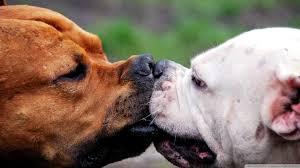 Dog aggression is a major dog problem for owners. understanding the causes of dog aggression, so you can overcome this dog problem. Dog aggression stems from the dog’s frustration and dominance. The dog’s frustration comes from a lack of dog exercise, and the dog’s dominance comes from a lack of calm-assertive leadership By Cesar Millan
Dog aggression is a major dog problem for owners. understanding the causes of dog aggression, so you can overcome this dog problem. Dog aggression stems from the dog’s frustration and dominance. The dog’s frustration comes from a lack of dog exercise, and the dog’s dominance comes from a lack of calm-assertive leadership By Cesar Millan
Maximizing the potential for a great relationship between your new dog and your current dog is a two-step process. It involves the actual introduction and then management of the new dog in your home. We’ll start with introductions and then give you guidelines for helping your dogs through the initial transition weeks of being together in your home.
Introductions
- Leave your current dog at home when you pick up your new dog. One of the worst things you can do is to just throw the two of them together in your car and hope for the best!
- Introduce your dogs on neutral territory, like on a short walk through your neighborhood, in a nearby park or in a friend’s yard. Have two people, one to handle each dog, while keeping the dogs on leashes.
- To minimize tension, try to keep the dogs’ leashes loose so that they’re not choking or feeling pressure on their throats.
- Don’t force any interaction between the dogs. If the dogs ignore each other at first, or if one dog seems reluctant to interact with the other, that’s okay. Give both dogs time to get comfortable. They’ll interact when they’re ready.
- Make the introduction positive and light-hearted. As the dogs sniff and get acquainted, encourage them in a happy tone of voice. At first, allow just a few seconds of sniffing. Then gently pull the dogs away from each other and let them walk around with their handlers. After a minute or two, you can lead the dogs back together and allow another several seconds of sniffing. These brief greetings help keep the dogs’ interactions calm and prevent escalation to threats or aggression. You can also interrupt their interactions with simple obedience. After a brief sniff, lead the dogs apart, ask them to sit or lie down, and then reward them with treats.
- Closely observe the dogs’ body language. Their postures can help you understand what they’re feeling and whether things are going well or not. Loose body movements and muscles, relaxed open mouths, and play bows (when a dog puts his elbows on the ground and his hind end in the air) are all good signs that the two dogs feel comfortable. Stiff, slow body movements, tensed mouths or teeth-baring, growls and prolonged staring are all signs that a dog feels threatened or aggressive. If you see this type of body language, quickly lead the dogs apart to give them more distance from each other. Again, practice simple obedience with them individually for treats, and then let them interact again—but this time more briefly.
- Once the dogs’ greeting behaviors have tapered off and they appear to be tolerating each other without fearful or threatening behavior, you’re ready to take them home. Before you take them inside, walk them together around your house or apartment building. Keep them leashed.
- Be patient. Bringing a new dog home requires that everyone make some adjustments, especially your current pets. And it will take time for your dogs to build a comfortable relationship.
.
The First Couple of Weeks at Home
- It’s crucial to avoid squabbles during the early stages of your dogs’ new relationship. Pick up all toys, chews, food bowls and your current dog’s favorite items. When dogs are first forming a relationship, these things can cause rivalry. These items can be reintroduced after a couple of weeks, once the dogs have started to develop a good relationship.
- Give each dog his own water and food bowls, bed and toys. For the first few weeks, only give the dogs toys or chews when they’re separated in their crates or confinement areas.
- Feed the dogs in completely separate areas. Pick up bowls when feeding time is over. (Some dogs will compete over bowls that recently contained food.)
- Keep the dogs’ playtime and interactions brief to avoid overstimulation and over arousal, which can lead to fighting.
- Confine the dogs in separate areas of your home whenever you’re away or can’t supervise their interactions.
- Give your new dog his own confinement area. When the dogs are separated, it might be a good idea to let them get to know each other through a barrier, like a baby gate. Your new dog should be gated in his confinement area, and your current dog should be free to move around and visit when he wants to.
- When the dogs are interacting, interrupt any growling or bullying behavior with a phrase like “Too bad,” and then quickly separate them for several minutes. Then allow them to be together again. If your dogs seem to react poorly to each other often, don’t hesitate to contact a professional who can help you.
- Be sure to sincerely praise your dogs when they are interacting nicely.
- Spend time individually with each dog. Give each of them training time with you and playtime with other dogs outside your home.
- If your dogs are very different in age or energy level, be sure to give the older or less energetic one his own private space where he can enjoy rest and down time.
Non Spay/Neuter Pets (Spraying and Aggression)
Identifying the cause is necessary to determine whether the aggression is problematic or simply normal behavior. This also helps in selecting the most appropriate means of addressing any behavior problem. Common factors may include whether a pet has been spayed or neutered. No matter the cause, however, it is most important to stay calm and remember that your pets behaviors are also their means of expression.
If your pet is not spayed or neutered, behavior problems can arise. The best way to prevent aggression is to have this safe, routine procedure performed at an appropriate age. This generally reduces aggressive behaviors, bad temperaments, house training problems, and the risk of running away, as well as the potential for unintended pregnancies.
Should aggressive behavior prove troublesome before your pet is ready for his or her procedure, it is best to keep the pets separated. This may involve confinement, but it is only temporary and will allow the pets some relief until the procedure is performed.
Once spayed or neutered, keep in mind that it may take up to one month after the surgery for the dog to exhibit appropriate behavior. You will find that once you pet is spayed/neutered the urine smell will decrease, Urine Marking for territory and Aggression will Stop.
Health Issues
Sometimes a dog will suddenly act aggressive for medical reasons. Any abnormal behavior or sudden change in behavior should be checked out by your veterinarian as soon as possible. If you spend time with your dog and get to know him, you will notice any changes in his behavior and habits right away. If there is a sudden change, don’t assume your dog is misbehaving. Check with your veterinarian first.
Aggressive behavior is a natural tendency in dogs but must be controlled for the safety of humans and other animals.
Dogs have a natural instinct for aggressive behavior. Growling, biting, snapping, nipping and lunging are normal dog behavior, but it is not acceptable for pets who are companion animals. The safety and of humans and other pets should have first priority, and dogs who exhibit aggression should be taught to behave appropriately.
Aggression is a common problem and the first step toward solving the problem is to consult your veterinarian. Pain or other underlying physical conditions may cause a usually docile dog to snap or bite. A dog who has a sore limb due to arthritis might snarl at a child who inadvertently causes pain. Hypothyroidism, a low level of the thyroid hormone, can cause a dog to become anxious. Medical treatment may alleviate the condition and return the dog to his mellow self. If medical problems are ruled out the vet may refer you to a behaviorist who will evaluate your dog’s behavior and develop a plan to moderate the behavior.
There are many reasons a dog may become aggressive. Some breeds are genetically predisposed for aggressive behavior. Early life experiences, hormonal surges, gender, physiological state, and external stimuli can all play a role in creating an aggressive personality. Unfortunately some owners actually encourage aggressive behavior in their dogs, perhaps to compensate for their own inadequacies.
The owner should keep a journal of the dog’s behavior when he shows aggression. Knowing what appears to cause the behavior, how often it occurs, who the behavior is directed toward and the specific behavior (growling, biting, snapping) will help the behaviorist determine the dog’s motivation and pattern of behavior. Videotaping the incidents may be helpful. Many dogs who aggressively protect their territory may not exhibit such behavior at the vet’s office or when with the behaviorist.
Dominance-related aggression is the most common type. Dogs are pack animals, and they are not democratic! Dogs have their own social rules and established hierarchy within the pack. Household dogs consider the family their pack and may direct their aggression toward family members and other pets. Dogs usually accept adults as their pack leader but may consider children “litter mates” and try to dominate them.
Owning two or more dogs who are similar in breed, age, size, and gender (such as brothers from the same litter) can cause aggression that is similar to “sibling rivalry.” Competing for attention and their place in the family “pack” can cause them to fight among themselves.
Adult males in the same household will often fight for dominance or territory, but two females may fight as well. Dogs of opposite gender will get along much better in the same household. It may be necessary to keep same-sex dogs separated. Owners may unwittingly add to the problem by coming to the defense of the subordinate dog. This encourages the subordinate dog to be bold enough to challenge the alpha dog. Support the alpha dog’s position in the “pack” by feeding him first, greeting him first, or letting him out the door first. This isn’t our human idea of “fairness” but it is one dogs will understand.
In multiple dog households, feed dogs separately if they tend to fight over food. Never step in to separate dogs who are fighting. Distract them with a loud noise, a spray of water, or a blanket thrown over them. Exert your authority as leader of the pack and calmly but firmly intervene when you can tell a fight is about to start. Give them the message, as you would your own children, that you don’t care who started it, just knock it off!
Territorial aggression is directed toward people or animals who are not part of the family. Dogs have a natural instinct to protect their territory, owners, and family members. Many people own dogs for the security and protection they offer, but overly aggressive dogs may harm visitors or prevent emergency medical personnel from administering aid not to mention the scare they can give the poor mailman! Prevent such territorial behavior by properly socializing your new puppy so he doesn’t view strangers and other animals as a threat.
Aggression may also be fear-induced. Some dogs are just naturally more anxious and jumpy. Loud noises and noisy, active children may upset them. Fearful dogs may also be created by owners who treat them harshly, physically punish them, crate them inappropriately, or by other adverse life experiences. When approached a fearful dog will fold his ears back, tuck his tail, and try to escape. If escape isn’t possible (being chained up or cornered) he is very likely to bite.
Fearful dogs may be treated with anti anxiety medication or desensitization therapy. A dog who is afraid of strangers may be taken out to the park on a leash on several occasions. Gradually bring the dog closer to strangers, but never close enough to cause an extreme reaction. Don’t reassure the dog when he acts fearful; this only reinforces the behavior. Ignore such behavior and praise him when he acts with confidence.
Maternal aggression occurs when the litter of a mother dog is approached. This is an understandable protective instinct and doesn’t necessarily need treatment, unless the mother is overly aggressive. She’s doing what nature intends by protecting her young. Teach the kids to respect this maternal instinct and leave those cute puppies alone!
Females experiencing false pregnancy may also become snappish. In the case of aggression caused by hormonal surges, spaying or neutering may reduce the problem.
Aggression may be redirected from one source to another. A dominant dog who is barking out the window at a cat in the yard and is pulled away by the owner may direct his aggression at another dog in the household.
Take steps to ensure the safety of your family, friends and visitors until you are able to get treatment for your dog. A comfortable basket-style muzzle that allows the dog to drink and eat but not bite may be necessary. Never allow children to be with the dog without supervision, or keep the dog in a separate room. Teach children to treat dogs with respect, to never tease or hurt them, and to leave dogs alone when they are eating, sleeping, or chewing on a bone or toy.
Keep the dog on a leash at all times. In the house the dog should wear a buckle collar with a thin nylon lead attached that the dog can drag around. This will give you a measure of control without handling the dog and risking your own safety. A head collar will give even better control. Do not physically punish a dog at any time. This creates a fearful dog who mistrusts humans and worsens the aggressive behavior.
Recognize situations that create aggression and when you feel such a situation may arise interrupt with a distraction such as an incompatible command (“down-stay”), play time, or a food treat. Adequate exercise and obedience training can help control a dog’s natural tendency toward aggressive behavior
Dogs and Cats
Regardless of whether you are getting a new cat or a new dog, the first introduction between your current pet and your new pet is a very important part of the process. Here are four steps that can help you ensure a successful meeting – See our bringing your Pet Home page for introduction tips.
Matching Cats and Dogs
- If you’re thinking of getting a cat for your dog or a dog for your cat, it’s important to consider both animals’ personalities. It may be helpful to look for a companion that has already been exposed to the other species in the past.
- If a dog attempts to aggressively chase, pin, pick up or otherwise “manhandle” any cat, it is best to not even consider getting a cat — or at least to proceed with caution. Additionally, a dog who growls, lunges at or obsessively barks at a cat would probably do best in a cat-free environment. Likewise, a cat who growls, swats at, runs from or hides from dogs would probably prefer to not live with a dog.
- If a dog loves chasing things, then a fearful, shy cat who runs away probably wouldn’t be the best choice, as it could trigger the dog to chase. Similarly, an energetic cat who runs and pounces would fall into this same category. A better match here would be a calm, confident cat who will not run (in fear or play).
- If a dog plays roughly, it is best to avoid kittens or elderly cats who can easily be hurt. Instead, stick to playful adults who are interested in play, but are also confident enough to take care of themselves. If a cat is rambunctious or playful, a dog that is playful, but gentle, could be a great option.
- If a dog or cat is elderly, laid back, quiet or anxious, then a calm counterpart would be best. Avoid rambunctious companions who may annoy, frighten or otherwise bother the other pet
Introducing you Cat to a dog
When you bring home your Cat you should always start in a “Safe Room” that has baby gates to keep everyone safe. Keep your dog on a leash so you have control.
If the dog stares at the cat or the door separating the cat, try to distract him and get him to look away with treats, a happy voice or by gently guiding the dog away on a leash. Once the dog is away from the cat, try offering a treat. If he takes it, repeat this process until he is no longer focused on the cat or door.
Warning Signs
- If the dog remains overly focused, does not take his eyes off the cat or the door, completely ignores you or lunges suddenly as soon as the cat moves, this is probably a dangerous match. If you are looking for a dog for your resident cat, try another dog. If this is your dog, you should probably not get him a cat.
- If at any time the dog lunges toward, growls, snaps at or shows any aggression toward a calm, quiet, still cat, this match will probably not work out. The same holds true if a cat attacks a calm, quiet dog. If you are committed to make the relationship work, you will probably need a professional at this point.
- If you are looking for a cat for your dog, and your dog displays questionable behavior around a cat who is growling, hissing and swatting, try again with another, calmer cat. If he continues to display questionable behavior around multiple cats, it is likely he should not live with cats.
- If it is your cat who is growling, hissing or swatting , give the cat a break and try again on another day. You might also need to try a different dog. A cat who continually hisses and growls at all types of dogs will likely not want to live with dogs. Your cat may tolerate a dog, but she probably won’t be happy — which is an unfair situation for her.
- If the cat stops eating, drinking, using the litter box or visiting with family members, she is not happy. You might want to consider finding a better match or contacting a professional animal behaviorist for advice.


